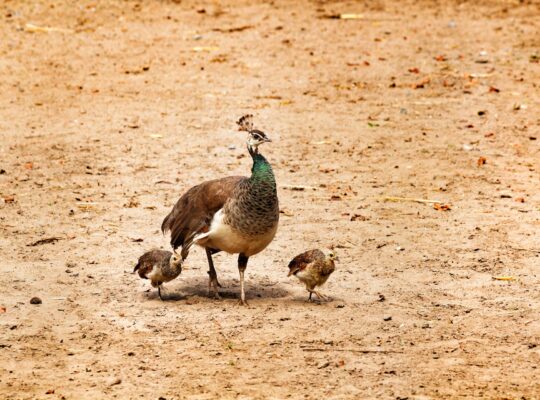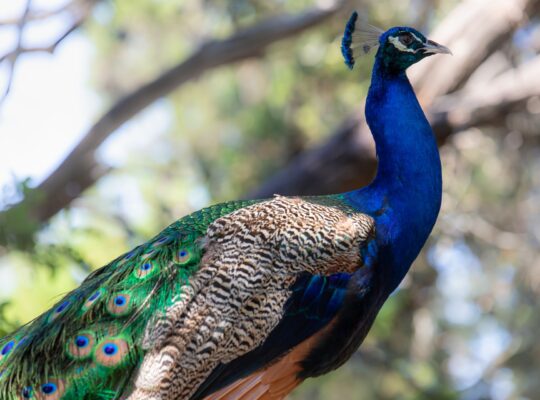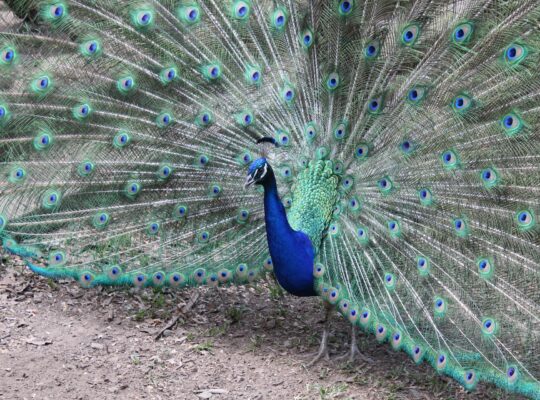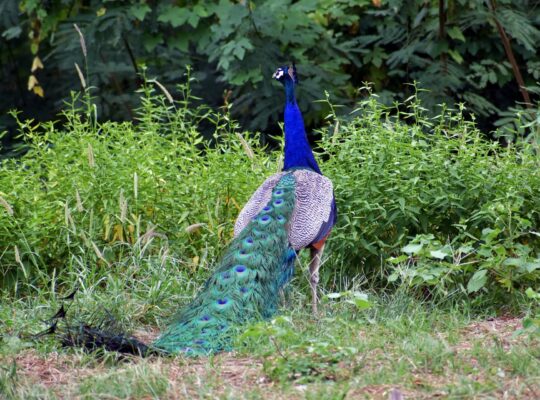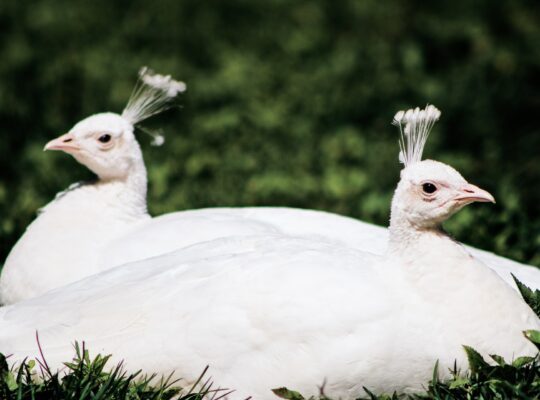Peacocks are noted for their stunning appearance and booming calls, which have earned them the reputation of being regal birds. They are also quite shy and often show a great deal of anxiety when confronted by humans or other animals. Let’s see some examples of what peacocks are afraid of.
- Most peacocks are terrified by other animals. When threatened by predators or larger animals, they frequently flee or hide. Considering how little and defenseless they are, bigger creatures are more likely to target peacocks.
Also, if they haven’t been socialized, they could be scared of people. When approached by a human, peacocks may grow frightened and flee in the other direction. - 2. Loud sounds might also scare peacocks. They have good hearing, and the sound of loud machinery or thunder can startle them.
They may also be afraid of sudden movements, like when someone walks up to them out of the blue or when a big bird flies over them. - 3. Another thing that peacocks are afraid of might also be scared of things they don’t know, like a broom or a stick. They might be afraid of these things because they don’t know what they are or whether or not they are dangerous. Peacocks may also be scared of shiny, reflective, uneven, or bumpy surfaces that they don’t know.
To make sure a peacock feels safe and secure, it’s important to give them a quiet, comfortable place to live. This means giving them a quiet place away from loud noises, dangerous animals, and strange things.
it’s also important to be gentle with the bird and give it plenty of time to get used to its new home before bringing in new things or people. If you know how to care for and understand them, peacocks can make great pets.
Peacock behavior meaning
In order to answer the question of what are peacocks afraid of, we need to understand a peacock’s behavior.
Peacocks are very active birds, so it can be fun to watch how they act. Most of the time, they like to hang out with other birds and can be seen in groups of up to 15 birds. You can see them strutting around, playing, and chasing each other while showing off their beautiful feathers.
This is a sign of being in charge and a way to show interest. Peacocks also make different sounds, like loud honks, low clucks, and whistles.
Peacocks spread their feathers and make loud noises when they feel threatened to scare away predators. This is called a show of aggression. They also talk to each other by raising or spreading their feathers to get their point across.
In the same way, peacocks have a strong sense of territory. Peacocks, like other animals, will protect their area against intruders. Peacocks will frequently make a lot of commotion and show dominance when another peacock enters their region by rising very tall and fluffing out their feathers.
Overall, the way peacocks act is very interesting to watch. Their dominance and sense of territory are impressive, and the way they interact with each other is interesting. You can watch them in most parks and gardens, so it won’t be hard to find them if you want to.
Male peacock behavior
Male peacocks exhibit a variety of behaviors that are essential to their survival. The most obvious behavior for a male peacock is their courtship display. Male peacocks will spread out their tail feathers and fan them out to attract a mate. The male will also make calls, bob his head, and make a strutting display. This behavior is meant to catch the attention of the female, and if successful, will help the male to find a mate and reproduce.
The male peacocks also use their feathers to keep predators away. When a peacock feels scared, he puffs up his feathers to make himself look bigger and scarier. This behavior is meant to scare away potential predators and keep the peacock safe.

Male peacocks also set up social orders and try to be the most powerful male in the area. They do this by being aggressive and driving other male peacocks away from their territory, for example. This helps keep the peace in a large flock, and it also lets the males protect their mates from other males.
In general, male peacocks have a number of behaviors that are crucial to their continued existence. These behaviors include: They utilize their feathers to attract mates and protect themselves, and they develop social hierarchies in order to protect their partners and preserve peace.
Additionally, they use their feathers to distinguish themselves from other birds. Peacocks engage in a variety of behaviors, each of which contributes to their ability to live and have offspring.
Humane peacock deterrent
Peacocks may be kept away from gardens, residences, and other locations with peacock deterrents that aren’t harmful to the animals. Peacocks can be discouraged from entering particular locations by using these deterrents, or they can be encouraged to leave certain regions altogether by using these deterrents.
The most prevalent kinds of deterrents are those that produce noise, include motion detectors to trigger sprinklers, or use chemicals to repel people.
Peacocks are sensitive to noise, so anything that makes a lot of it, such as blaring music or alarm bells, might make them feel uneasy and prompt them to leave the area.
Sprinklers that are actuated by motion are another good deterrent since the unexpected sound of the water might startle the peacocks and cause them to flee. It is possible to deter birds from a location by spraying chemical repellents, such as urine from a predator, on plants or all around the region.
In addition to the use of deterrents, there are also certain measures that do not involve the use of fatal force that may be employed to keep peacocks away. It may be possible to discourage birds from nesting in an area by planting thorny plants and bushes, such as holly.
It is also possible to create a physical barrier by planting dense plants and shrubs, which will prevent them from entering particular places.
Humane peacock deterrents can work well to keep these birds away from places they shouldn’t be. But keep in mind that peacocks are wild animals and can be dangerous if they feel threatened. Also, it’s important to be careful when using chemical repellents, since they can hurt both people and other animals.
To conclude, it is evident that peacocks may be scared of many different things, including predators, strange places, and loud noises. They are also easily threatened by other peacocks, especially males during the breeding season.
Consequently, if you want to keep peacocks away from a certain spot, you need to take their habits into account. Peacocks may be safely and humanely repelled from your yard with the use of audible devices and motion-activated sprinklers.


